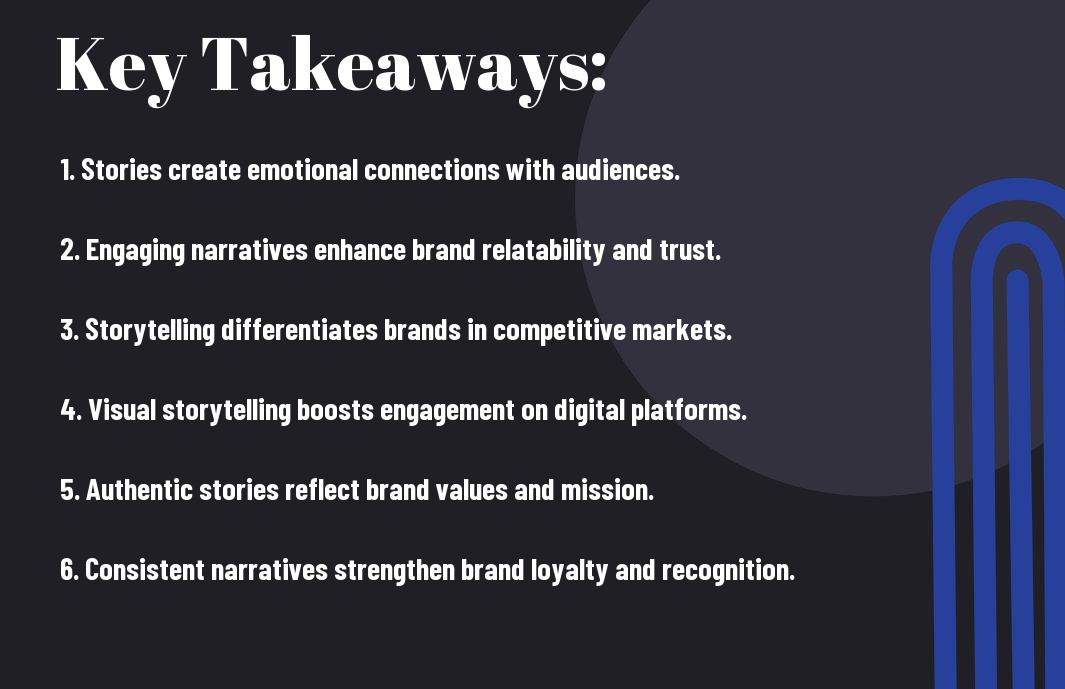
Just as you connect with others through the narratives that shape your life, effective marketing and branding leverage storytelling to forge deep relationships with consumers. By weaving compelling tales around your brand, you can elevate your message and resonate with your audience on a personal level. This post explores how harnessing the power of storytelling can differentiate your brand, enhance customer loyalty, and drive sales, ensuring your message leaves a lasting impact in an ever-evolving marketplace.

The Importance of Storytelling in Marketing
For modern marketers, storytelling presents a powerful way to engage audiences and forge lasting connections. By weaving narratives that resonate with your target demographic, you not only capture their attention but also create a memorable experience that can influence their perceptions and purchasing decisions. This approach enhances your marketing strategy, allowing for a more compelling presentation of your brand values and message.
Emotional Connection
Storytelling fosters an emotional connection between your brand and your audience. You can evoke empathy, joy, or even nostalgia by sharing relatable narratives that reflect your audience’s experiences and aspirations. This deeper engagement encourages customers to invest emotionally in your brand, leading to greater loyalty and advocacy.
Building Brand Identity
Against a backdrop of countless brands vying for attention, storytelling is a strategic tool for establishing your unique identity and value proposition. You can differentiate yourself in the marketplace by crafting a narrative that conveys your mission and brand essence, helping potential customers understand what sets you apart from competitors.
Consequently, your storytelling approach should encompass the values, vision, and personality of your brand. Your story should resonate with your audience’s needs and desires, aligning with their beliefs and lifestyle. A compelling narrative not only reinforces your brand identity but also invites customers into a dialogue, making them feel like part of your journey. This connection can transform casual buyers into loyal advocates who share your story with others.
Types of Storytelling in Branding
Some effective storytelling types in branding can truly enhance your brand’s impact. Understanding these methods will allow you to engage your audience more deeply. Here’s a quick overview:
| Emotional Stories | Connect with your audience’s feelings. |
| Founder’s Stories | Share your journey and origins. |
| Customer Stories | Highlight real experiences from users. |
| Vision Stories | Articulate your brand’s future aspirations. |
| Challenge Stories | Detail how you’ve overcome adversity. |
After exploring these types, you can select the right storytelling method that resonates with your audience and aligns with your brand’s mission.
Customer Testimonials
Before showcasing your brand, consider the authentic voices of satisfied customers. Their testimonials serve as powerful narratives that provide social proof and credibility. By sharing genuine stories of customer experiences, you not only reinforce trust but also illustrate the real-world impact of your products or services.
Brand Narratives
Above all, brand narratives encompass the overarching story that communicates your core values and mission. These narratives shape your brand identity and resonate with audiences on a deeper level, providing context for your offerings.
With well-crafted brand narratives, you can convey what your brand stands for, creating a strong emotional connection with your audience. This storytelling approach allows you to communicate your unique value proposition, fostering loyalty and encouraging consumers to share your story with others. By integrating brand narratives into your marketing strategy, you ensure consistency and resonance with your target audience.
Crafting Your Brand Story
Despite the myriad of brands in today’s marketplace, your unique story sets you apart. Crafting a compelling brand narrative allows you to connect the dots between what you stand for and how potential customers perceive you. By weaving together the values, mission, and aspirations of your brand, you create a memorable and relatable identity that resonates with your audience, forging a lasting bond that can drive loyalty and engagement.
Identifying Core Values
Among the first steps in crafting your brand story is identifying your core values. These values are the guiding principles that reflect what you believe in and what your brand represents. By clearly defining them, you not only strengthen your narrative but also create an emotional connection with your audience, helping them understand the very essence of who you are and what you strive to achieve.
Engaging Your Audience
Core to successful storytelling is the ability to engage your audience. You have the power to use storytelling techniques that draw your audience in, making them feel part of your brand’s journey. When you share authentic experiences or challenges, your audience will relate and invest emotionally in your brand.
And as you master the art of engagement through storytelling, consider incorporating personal anecdotes, customer testimonials, or vivid imagery to create powerful emotional connections. By encouraging interaction, whether through social media discussions or community events, you enable your audience to share their own stories and experiences with your brand, fostering a sense of belonging and loyalty. By valuing their input and creating a dialogue, you can elevate your brand’s story to new heights and create a vibrant community around your mission.
Platforms for Storytelling
To effectively harness the power of storytelling in your marketing and branding efforts, you should explore various platforms that resonate with your audience. Each platform provides unique features that enhance your narrative, whether through visual storytelling, written content, or interactive experiences. Selecting the right mix of platforms can amplify your messages and cultivate deeper connections with your target audience.
Social Media
For brands today, social media serves as a dynamic stage for storytelling, enabling you to connect directly with your audience in real-time. By leveraging the interactive nature of platforms like Instagram, Facebook, and Twitter, you can share authentic stories that not only engage but also foster community and loyalty around your brand.
Content Marketing
Above all, content marketing allows you to tell deeper, more comprehensive stories that educate and inform your audience. With a well-structured content strategy, you can use blog posts, videos, whitepapers, and eBooks to elaborate on your brand’s mission and values, creating a narrative that is compelling and relevant to your customers’ needs.
A strong content marketing strategy allows you to explore diverse storytelling formats, providing your audience with valuable insights and experiences. By offering compelling narratives through various content channels, you can not only showcase your products or services but also establish your brand as a thought leader in your industry. Engaging storytelling through content fosters trust and drives engagement, ultimately guiding your audience through the customer’s journey and encouraging them to take action. This comprehensive approach ensures that your brand story resonates long after the initial interaction.
Measuring the Impact of Storytelling
Your ability to measure the effectiveness of storytelling in your marketing efforts can significantly influence your brand’s success. By tracking the right metrics, you can gain insights into how your narratives resonate with your audience and ultimately drive engagement, conversions, and loyalty. This data not only helps you refine your storytelling strategies but also enables you to justify your marketing investments in a compelling way.
Key Performance Indicators
Above all, identifying the right key performance indicators (KPIs) is important for gauging the success of your storytelling. Focus on metrics such as engagement rates, website traffic, conversion rates, and social media shares to understand how well your stories are performing. Additionally, you could consider customer retention rates and brand sentiment to assess the deeper impact of your narratives on your audience.
Case Studies and Examples
Any effective storytelling strategy comes to life through tangible examples that demonstrate its impact. By looking at real-world case studies, you can see the metrics and data that support the effectiveness of storytelling in marketing.
- Coca-Cola: Their “Share a Coke” campaign led to a 2% increase in U.S. sales after years of decline, with over 500,000 photos shared on social media.
- Dove: The “Real Beauty” campaign increased sales by 700% over a decade while generating over 1.5 billion views on YouTube.
- Airbnb: The “Live There” campaign saw a 13% increase in brand engagement on social media, resulting in a substantial boost in bookings.
- Apple: Their storytelling approach in marketing iPhones led to a record of 1.2 billion units sold in Q4 2020, highlighting the effectiveness of emotional connection.
Studies consistently show that storytelling drives measurable results by enhancing emotional engagement with your brand. By leveraging data from these case studies, you can tailor your storytelling approach for maximum impact. Listen to your audience’s response, adjust your narratives accordingly, and watch how these insights can significantly improve your marketing effectiveness.
- P&G: The “Thank You, Mom” campaign generated over 400 million views, contributing to a 10% sales increase during the Olympics.
- Slack: Their blog storytelling resulted in a user growth of over 300% year-on-year, through engaging content that resonates with users.
- Patagonia: Their commitment to storytelling about environmental activism helped them achieve over $1 billion in revenue in 2020.
- GoPro: User-generated content shared through storytelling increased their customer involvement, leading to a 200% increase in revenue in 2015.
Challenges in Storytelling
Now that you understand the impact of storytelling, it’s important to address the challenges that come with it. Crafting a compelling narrative requires a balance between creativity and clarity, and failing to navigate these obstacles can weaken your brand message. You may find it difficult to engage your audience, stay relevant, or maintain authenticity throughout your storytelling efforts.
Keeping Authenticity
Below the surface of creative narratives lies the need for authenticity. You must ensure that your story aligns closely with your brand values and resonates with your target audience. When your narrative feels genuine, it encourages trust and loyalty, leading to deeper connections with your customers.
Avoiding Over-Saturation
Between the constant stream of content and marketing messages, avoiding over-saturation is vital for effective storytelling. Your audience is bombarded with various narratives daily, making it challenging for your message to stand out. You’ll need to find unique angles and fresh perspectives in your storytelling approach that resonate with your audience without falling into repetitive patterns.
It’s important to strike a balance between storytelling frequency and quality. Overloading your audience with stories can diminish their impact and lead to disengagement. To avoid this, focus on crafting fewer but more powerful narratives that capture attention and provoke thought. Evaluating your content strategy regularly will help you weave in your storytelling elements in ways that feel refreshing rather than overwhelming.
Conclusion
On the whole, leveraging the power of storytelling in your marketing and branding efforts allows you to forge deeper connections with your audience. By crafting compelling narratives that resonate with your target market, you can evoke emotions, build trust, and ultimately drive customer loyalty. As you implement storytelling techniques, you not only enhance your brand’s identity but also differentiate yourself in a crowded marketplace. Embrace storytelling as a vital aspect of your strategy, and watch how it transforms your brand’s engagement and resonance with your customers.
Leave a Reply